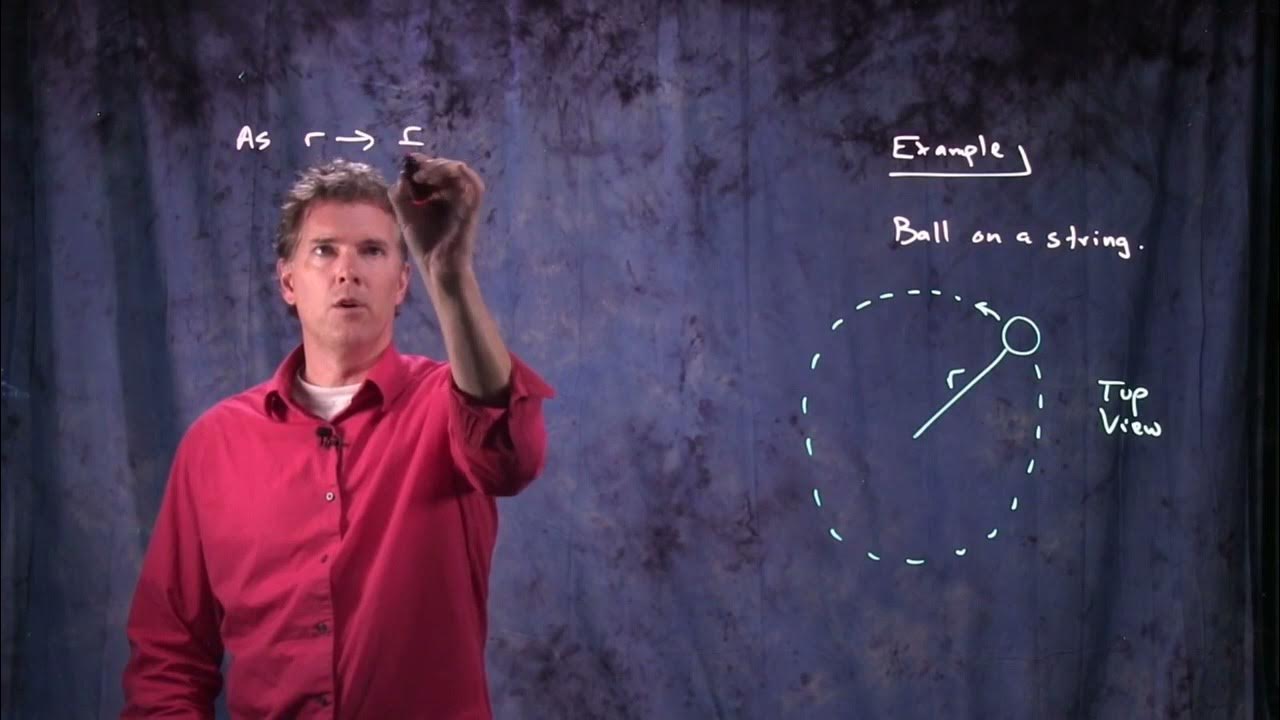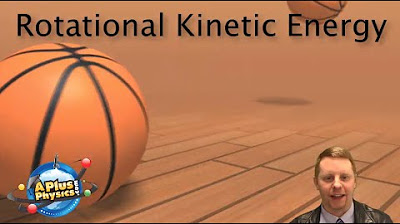Rotational Energy | Physics with Professor Matt Anderson | M12-17
TLDRIn this engaging lesson, Professor Anderson delves into the concepts of rotational energy and angular momentum using the classic ball on a string example. He explains how when the string's length is halved, the ball's speed increases, maintaining the conservation of angular momentum. The professor then connects this to the increase in kinetic energy, demonstrating how it translates into rotational energy. By rewriting the kinetic energy formula in terms of moment of inertia and angular velocity, he shows that the rotational energy increases as the ball's speed increases. The example of pulling the string to half its length results in the ball having four times the initial energy, highlighting the work done by the person pulling the string, which equals the change in kinetic energy. This insightful explanation clarifies the principles of energy transfer and conservation in a practical scenario.
Takeaways
- 📐 **Angular Momentum Conservation**: When the radius (r) of the ball on the string is reduced, the speed (v) of the ball increases to maintain the conservation of angular momentum.
- 🚀 **Speed and Radius Relationship**: The final speed (v_final) can be calculated using the initial speed (v_initial) and radii, with the formula v_final = (r_initial / r_final) * v_initial.
- ⚙️ **Kinetic Energy**: The kinetic energy of an object is given by one half the product of mass (m) and the square of the speed (v squared), or one half m * v^2.
- 🔄 **Rotational Energy**: The rotational energy of the ball on the string is equivalent to its kinetic energy, expressed in terms of moment of inertia (I) and angular velocity (ω) as one half I * ω^2.
- 🔗 **Moment of Inertia**: For a ball on the end of a string, the moment of inertia (I) is given by m * r^2, where m is the mass and r is the radius.
- 📈 **Energy Increase**: When the radius is halved, the rotational energy increases by a factor of four due to the increase in speed.
- 🔢 **Energy Calculation**: The final rotational energy is calculated as one half m * (r_initial / r_final)^2 * v_initial^2, which shows a fourfold increase when r_final is r_initial / 2.
- 🧭 **Work Done**: The increase in the ball's energy comes from the work done by the person pulling the string, which is equal to the change in kinetic energy.
- 🛠️ **Work-Energy Principle**: The work done on the ball by pulling the string is what increases its energy, adhering to the principle that energy is not created or destroyed.
- ⛓️ **Tension and Work**: The tension in the string does no work on the ball because it acts at a right angle to the velocity of the ball, where the cosine of 90 degrees is zero.
- 🤔 **Follow-Up Question**: The source of the increased energy is the work done by the person pulling on the string, which is a direct application of force over a distance.
Q & A
What is the principle behind the ball on the string problem discussed in the transcript?
-The principle discussed is the conservation of angular momentum. When the radius (r) of the circular path decreases, the speed (v) of the ball increases to maintain the same angular momentum.
How does the final speed (v_final) of the ball relate to the initial speed (v_initial) and the radii?
-The final speed of the ball is given by the formula v_final = (r_initial / r_final) * v_initial. If the radius is halved, the speed doubles.
What is the relationship between kinetic energy and rotational energy?
-Both kinetic energy and rotational energy are related to the motion of an object. Kinetic energy is given by (1/2)mv^2, while rotational energy, considering a ball on a string, can be expressed as (1/2)Iω^2, where I is the moment of inertia and ω is the angular velocity. They are similar in that they both describe the energy of motion, but rotational energy is expressed in terms of angular velocity and moment of inertia.
How does the moment of inertia (I) change when the radius (r) changes?
-For a ball on a string, the moment of inertia I is given by mr^2, where m is the mass and r is the radius. If the radius is halved (r_final = r_initial / 2), the moment of inertia also decreases by a factor of four (I_final = (1/4)I_initial).
What happens to the energy of the system when the string's length is decreased?
-When the string's length is decreased, the energy of the system increases. This is because the speed of the ball increases, leading to an increase in both kinetic and rotational energy.
What is the factor by which the final energy increases when the string's length is halved?
-The final energy increases by a factor of 4 when the string's length is halved, as shown by the calculation 2 * (m * v_initial^2) compared to the initial energy (1/2) * m * v_initial^2.
Where does the additional energy come from when the string's length is decreased?
-The additional energy comes from the work done by the person pulling on the string. As the string is pulled, work is done on the ball, which increases its speed and consequently its energy.
Why doesn't the string do work on the ball despite exerting tension?
-The string does not do work on the ball because the tension in the string is always perpendicular to the velocity of the ball. Work is only done when the force has a component in the direction of motion, and since the cosine of 90 degrees is zero, no work is done by the string's tension.
What is the formula for work done in the context of the string problem?
-The formula for work done (W) in the context of the string problem is W = F * d, where F is the force applied to the string and d is the distance over which the force is applied.
How is the work done on the ball related to the change in its kinetic energy?
-The work done on the ball is equal to the change in its kinetic energy. If no work is done by pulling the string, the ball would maintain its original speed and kinetic energy.
What is the law of conservation of energy, and how does it apply to the ball on the string problem?
-The law of conservation of energy states that energy cannot be created or destroyed, only converted from one form to another. In the ball on the string problem, when work is done on the ball by pulling the string, the kinetic and rotational energy of the ball increases, consistent with the conservation of energy.
What would happen to the rotational speed (ω) of the ball if the string is pulled further in?
-The rotational speed (ω) of the ball would increase if the string is pulled further in, as the speed (v) is directly proportional to ω (v = ωr), and the radius (r) decreases.
Outlines
🔄 Angular Momentum and Rotational Energy in Ball on a String Problem
Professor Anderson introduces the concept of rotational energy in the context of angular momentum. Using the ball on a string example, he explains how shrinking the radius (r) results in an increase in the ball's speed (v), which can be calculated by applying the conservation of angular momentum. The professor then connects the kinetic energy formula (1/2 mv^2) to the rotational energy by expressing v as omega times r, where omega is the angular velocity and r is the radius. The moment of inertia (I) for a ball on a string is mr^2, and thus the rotational energy becomes (1/2)Iω^2. By pulling the string, the radius decreases, and the rotational energy increases, which is mirrored by an increase in the kinetic energy of the ball. The increase in energy is fourfold when the radius is halved, and the source of this energy is the work done by the person pulling the string.
🔧 Work Done and Energy Transfer in the Ball on a String Scenario
The second paragraph delves into the source of the increased energy observed when the string's length is halved. The professor clarifies that energy is conserved and cannot be created or destroyed; thus, the ball's energy increase must be the result of work done on it. He refutes the idea that the string itself does the work, as the tension in the string is perpendicular to the velocity of the ball, which means no work is done due to the cosine of 90 degrees being zero. The professor concludes that the work is done by the person who pulls on the string, which is equivalent to the change in kinetic energy of the particle. This work results in the ball rotating with four times the initial energy, emphasizing the direct relationship between the work done and the energy transferred to the ball.
Mindmap
Keywords
💡Rotational Energy
💡Angular Momentum
💡Conservation of Angular Momentum
💡Moment of Inertia (I)
💡Kinetic Energy
💡Velocity (v)
💡Radius (r)
💡Work
💡Tension
💡Energy Transfer
💡Cosine of 90 Degrees
Highlights
The ball on the string problem is used to illustrate the concept of rotational energy and its relation to angular momentum.
When the radius (r) is reduced to half its length, the speed of the ball increases, maintaining the conservation of angular momentum.
The final speed (v final) can be calculated using the initial and final radii and the initial speed.
The kinetic energy of the ball increases when it is at half the distance and spinning faster, as kinetic energy is proportional to the square of the velocity.
Rotational energy is analogous to kinetic energy, expressed in terms of moment of inertia (I) and angular velocity (ω).
The moment of inertia (I) for a ball on a string is mr^2, where m is mass and r is the radius.
The increase in rotational energy is calculated by comparing the initial and final states of the system.
When the radius is halved, the final rotational energy is four times the initial energy due to the increase in angular velocity.
The work done on the system comes from the person pulling the string, as tension in the string does no work due to being perpendicular to the velocity.
The work done by pulling the string is equal to the change in kinetic energy experienced by the particle.
The principle of energy conservation is emphasized, stating that energy cannot be created or destroyed, only transferred or converted.
The concept of work being force over a distance is applied to explain the increase in the ball's energy.
The lecture provides a clear example of how the work done on an object can result in an increase in its energy state.
The problem-solving approach used in the lecture involves applying fundamental physics principles to real-world scenarios.
The lecture concludes with an invitation for students to seek clarification during office hours if the concepts are not clear.
The use of the ball on the string model serves as an accessible way to understand complex physics concepts such as energy, work, and angular momentum.
The mathematical derivations and equations are broken down in a step-by-step manner to aid understanding.
Transcripts
Browse More Related Video

Conservation of Angular Momentum | Physics with Professor Matt Anderson | M12-18

AP Physics 1 - Rotational Kinetic Energy

10. Rotations, Part II: Parallel Axis Theorem

Rotation Free Response Paragraph Questions (AP Physics 1)

AP Physics 1 review of Torque and Angular momentum | Physics | Khan Academy

Rotational kinetic energy | Moments, torque, and angular momentum | Physics | Khan Academy
5.0 / 5 (0 votes)
Thanks for rating: